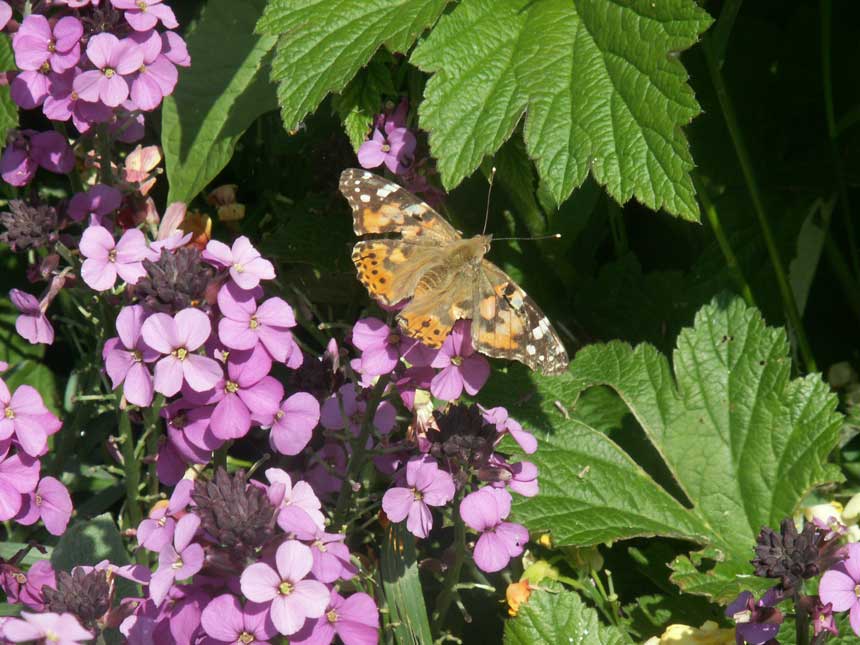
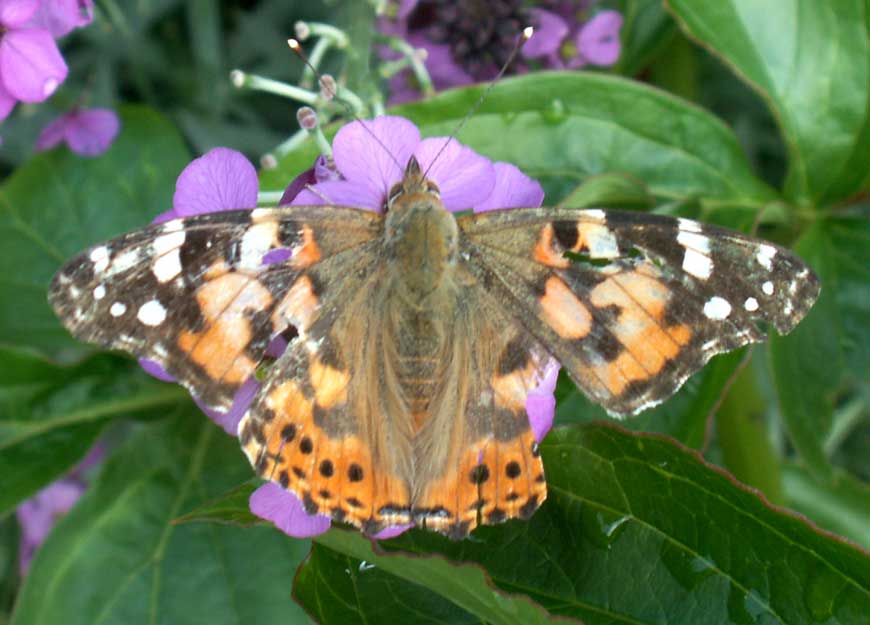
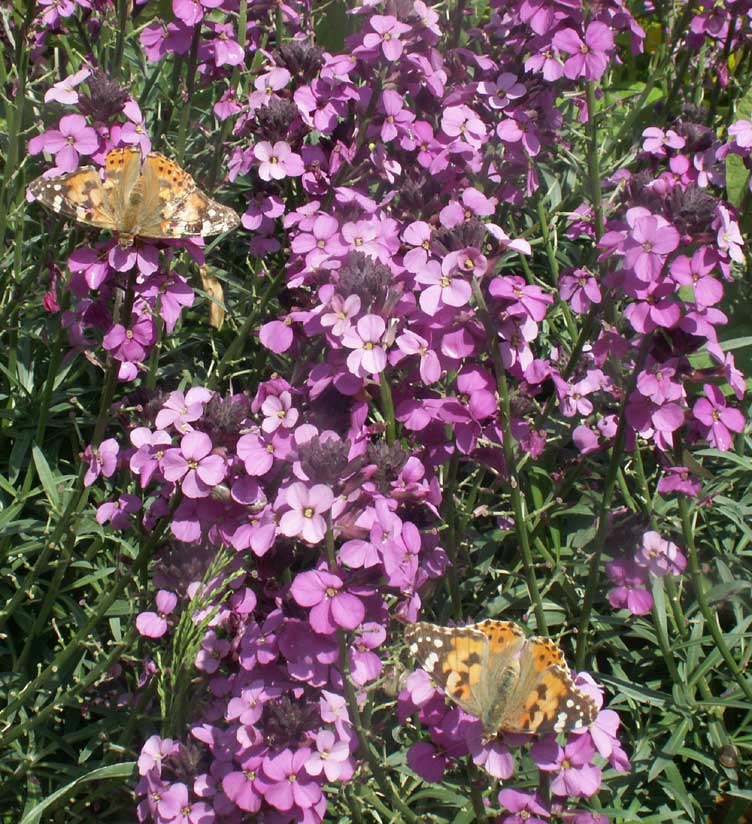
25
May 2006
In
my last visit to the garden at The Drive in north Shoreham, I discovered
that there were two resident Painted Lady
Butterflies, one intact and the other
one worn with one chunk out of each its wings.
 |
 |
 |
Again
it was the "Boules Mauve" Wallflower that
attracted these
butterflies and also a Red
Admiral, Large
White and a Small
White Butterfly, A Holly
Blue Butterfly flew around the garden
but did not seem to settle. The Painted Ladies
were later seen courting in mid-air.
Butterfly
Report for the Day
Whilst I was in the garden, no birds stopped to perch. A Blackbird a Starling and then three Wood Pigeons flew over. Later, two large Crows and then a Swallow flew overhead and the Rooks could be heard from the fir tree in the road outside. A Red-tailed Bumblebee, Bombus lapidarius, visited the wallflowers.
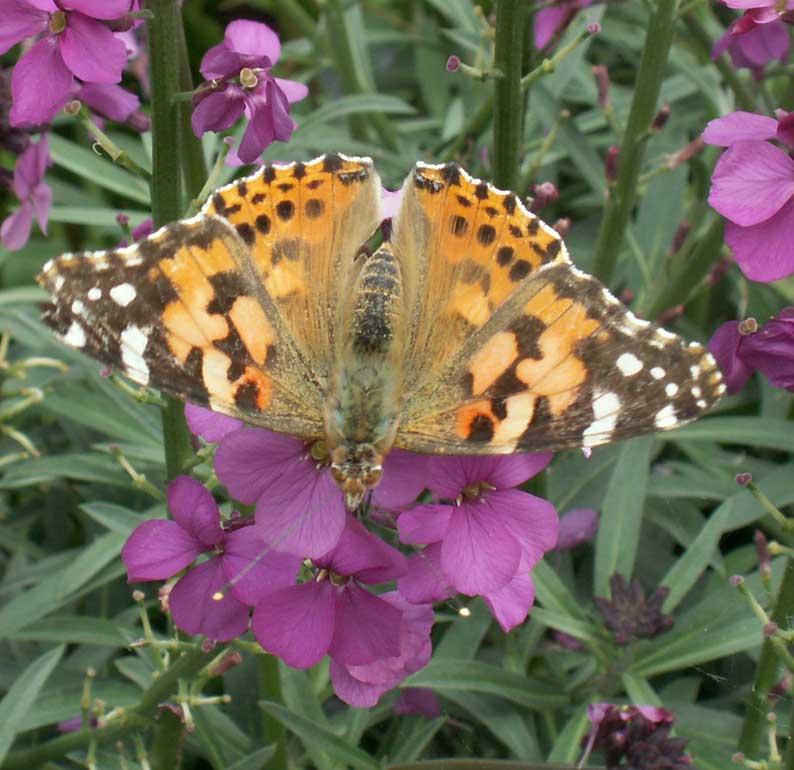 24
May 2006
24
May 2006
It
probably the same Painted Lady Butterfly
as before that landed on the wallflowers
in
a north Shoreham garden, followed later
by a Small
White Butterfly. This time the Painted
Lady was faded with a large chunk missing
from one wing.
18
May 2006
My
first Painted Lady Butterfly
of the year landed on a wallflower
in
a north Shoreham garden.
Butterfly
Report
11
May 2006
A
Large
White Butterfly an unexpected male Orange-tip
and two Holly Blues
visited.
Adur
Butterfly List 2006
 |
 |
 |
 |
The Large White Butterfly was my first of the year and the first one recorded in the Adur area. There was a lot of flying insect life with a large wasp, possibly a German Wasp, Vespula vulgaris, a Large Red-tailed Damselfly, and scores of hoverflies including twenty plus Rhingia campestris, and Syrphus and Epistrophe eligans. A Holly Blue Butterfly would not settle. A Small White Butterfly was noted and a spider amongst many. The two bees photographed above need checking for their identity. I think the first one is a Red Mason Bee, Osmia rufa, and the second one is a Leaf Cutter Bee, Megachile sp. The orange bee was a keen visitor to Bluebells. Bumblebees were noted including Buff-tailed and Red-tailed.
5 May
2006
A
glimpse of orange-red amongst the Bluebells
was my first small moth Pyrausta
aurata of the year in a north Shoreham
garden.
4 May
2006
A
Large
Red-tailed Damselfly was the first Odonata
of the year seen in a north Shoreham garden.
Large Red-tailed Damselfly
30
April 2006
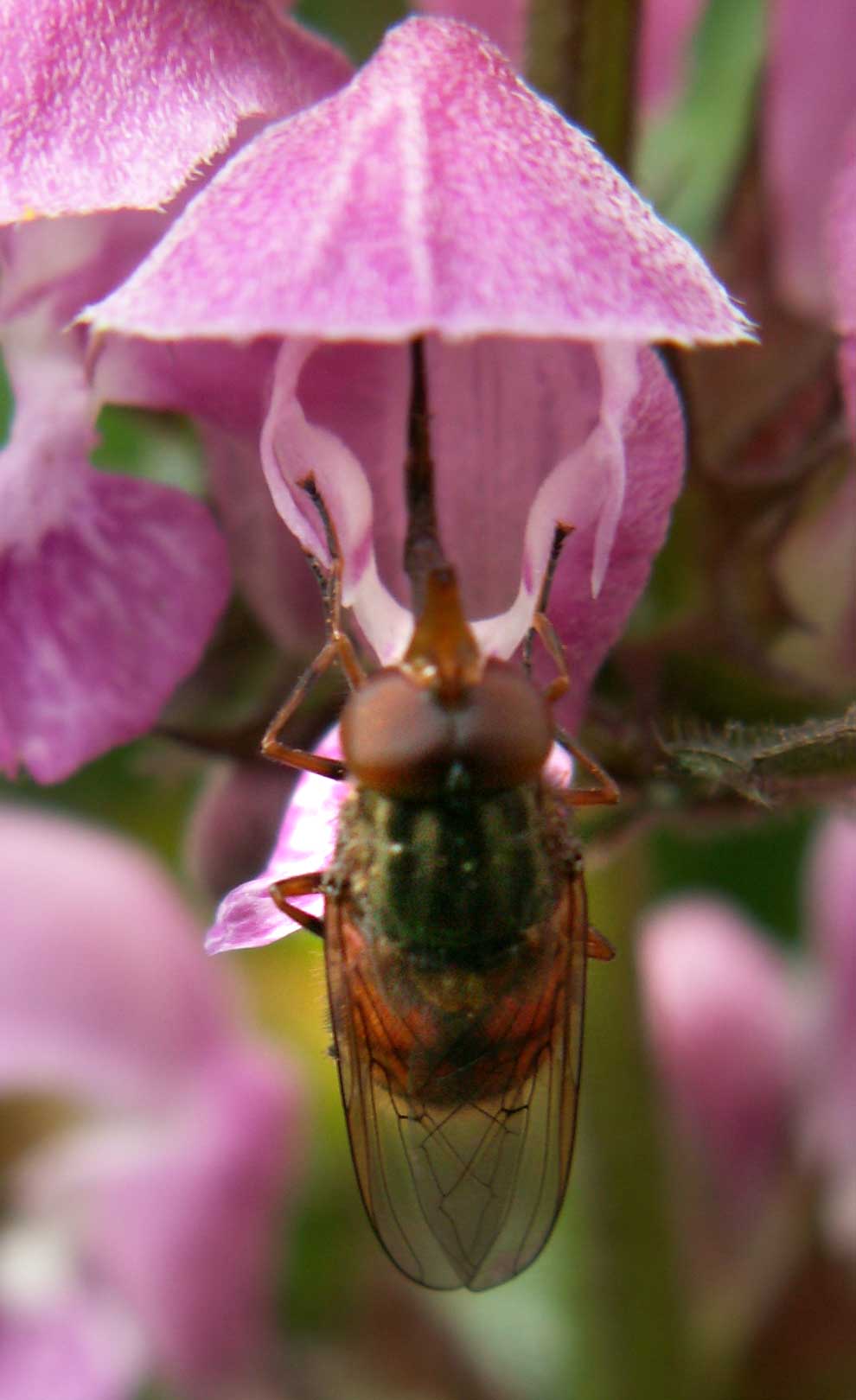 |
 |
The
photographic study shows the Rhingia
campestris
hoverflies
in the north Shoreham garden. The first one is visiting the Spotted
Deadnettle, Lamium maculatum, and its
long tongue is visible.
| 30
April 2006
The spider in the picture is well camouflaged on Spotted Deadnettle, Lamium maculatum, in a north Shoreham garden. My first tentative identification is that it is one of the wolf hunting spiders of the genus Pardosa, which are commonly found in gardens. Certainly lycosid and Pardosa, almost certainly Pardosa amentata. Unfortunately you cannot reliably identify Pardosa in the field. ID
and comments by Peter
Harvey on the
British
Spiders (Yahoo Group)
|
 |
29
April 2006
A
Common
Carder Bee
Bombus
pascuorum, was very keen on Spotted
Deadnettle, Lamium maculatum (pic).
| 27
April 2006
The usual flying insects were there: Common Bee-Fly, Bombylius major, Rhingia campestris, Syrphus and Eristalis hoverflies and another small hoverfly as well (illustrated on the right), probably a species of Platycheirus, but the only buzzing was from a Buff-tailed Bumblebee. |
 |
26 April 2006
 22
April 2006
22
April 2006
 |
Other
garden
species included at least one Eristalis
(probable
ID) and a definite Rhingia,
distinguished by its snout. There was also one of the small hoverflies
seen two days ago, possibly a Melanostoma.
Also, my first record of the immigrant Harlequin Ladybird, Harmonia axyridis spectabilis. Report & Image |
 |
 1
March 2006
1
March 2006
There
were two pairs of Common Frogs
in the pond, they appeared to be courting, but there was no sign of spawn.
Nine species of bird visited the garden and two Herring
Gulls perched on the roof.
16
February 2006
A
single Common Frog
is seen in the garden pond with three Comet
Goldfish actually seen as well as a juvenile
fish. There could have been more than one
frog
and they could have arrived a few days earlier. Five
species of garden bird were seen immediately: Greenfinch 1, Collared
Dove 1, Starling
1, Blue
Tit 1 and Robin
1, followed by a Blackbird and
a Chaffinch
within
a minute.
In
the garden a relatively few nine species of birds were recorded during
February, in order of prevalence: Starling
14, Greenfinch 9, Robin
5, Blue Tit
5,
Jackdaw
4, Blackbird
4, Collared Dove
3, Chaffinch 2
and Wood Pigeon
1.
Garden
Bird Database 2006
12
February 2006
The
first Chaffinch
of the year (last seen in November) was seen briefly in the garden, but
not positively identified until it was seen again four days later. There
were no frogs seen in the pond, but in the teeming rain my look was brief.
Garden
Bird Database 2006
28-29
January 2006
Big Garden Birdwatch
2006
14
different birds were recorded in the garden during the month of January,
in order of prevalence: Starling
47, Greenfinch 46, Jackdaw
27, Blue Tit
25, Blackbird
10, Collared Dove
9, Wood Pigeon
9, Robin 4,
House
Sparrow 3,
Dunnock
2,
Goldcrest
2,
Herring
Gull 2, Great Tit 1 and Magpie
1.
Garden
Bird Database 2006
7 January
2006
A
first there were no birds to be seen, followed by a modicum of activity
and then a tremendous flurry of feeding birds including at least one and
probably two Goldcrests,
the first seen in the garden since 16
February 2004. The Goldcrests
may have been attracted to the tubs of standing water or the small pond.
My first mammal of the year was a House
Mouse amongst the rockery. Eleven species
of bird seen actually landing in under an hour was the most of this year
and the most since Christmas Day.
A record 14 species were seen on 22
December 2005.
Garden
Bird Database 2006
5 January
2006
The
was a tremendous amount of continuous activity in the back garden of 40
The Drive (near Buckingham Park), (TQ
219 063), dominated by half a dozen Blue
Tits seen all at one time feeding on seed
and sunflower mix, nipping at buds on shrubs and dipping their beaks in
standing water in tubs and there were at least eight different birds, very
colourful and active. They exceeded the performance of the same number
of querulous Greenfinches.